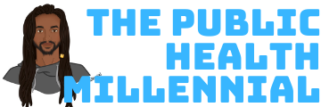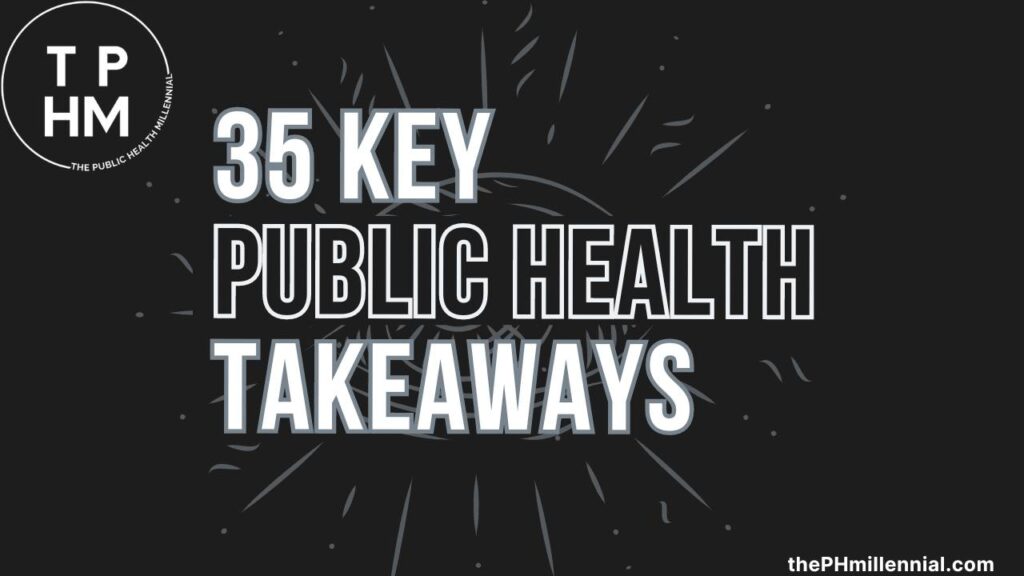35 Takeaways from National Public Health Week.
7 Panels. 7 Public Health Topics. 17 Panelist. 7+ hours of conversations.
100% invaluable insights.
A successful National Public Health Week was had!
When i started my public health journey in 2017, I wish i had known that there were so many ways to impact health and populations health through public health.
All of these takeaways come from the National Public Health Week.
(Join the Public Health Community)
National Public Health Week Themes
Civic Engagement
Healthy Neighborhoods
Climate Change
New Tools and Innovations
Reproductive and Sexual Health
Emergency Preparedness
Future of Public Health
Watch the National Public Health Week panel playlists below.
Civic Engagement and Public Health Takeaways
1. Conversations are the beginning of any civic change
- Overcoming lack of civic engagement starts within each of our communities.
- We must know the concerns of the community.
- This can start by having conversations with your neighbors, friends, family.
- Then get collectively organized and advocating for the issues that are important to your community.
2. Social media is a tool to improve civic engagement
- Instagram is a tool to improve civic engagement.
- 60% of US adults get news from Instagram.
- Making it a viable platform to educate audiences on pressing topics and to maintain public relevance.
- Instagram should be leveraged to get more young people involved in voting & civic engagement.
3. There are ways to have impactful meetings with elected representatives
- Impactful conversations with elected officials can be simple.
- Some of the most impactful conversations are short, pointed, and concise.
- Effective meetings frame: the problem + the solution(s) + the process to get to the solution.
- This will be backed by stories, data & the need for consistent advocacy.
4. The small percentage of Black men making up Master of Public Health Graduates is an advocacy issue
- Only 3.17% of Black men graduate with an MPH.
- We need to do a better job of sharing public health with disinvested communities.
- Share the value of the work and the impact you can have on your own community.
- Getting into public health is non synonymous with getting an MPH – we need to talk more about it.
5. Take small steps to be civically engaged today
- Call to actions for you to be more civically engaged.
- Find your people.
- Get involved – in small & big ways – however you can.
- Start conversations with neighbors and collectively identify concerns in community.
- Reach out to elected officials and advocate for your needs.
(Join the Public Health Community)
Healthy Neighborhoods and Public Health Takeaways
Healthy neighborhoods are essential for community well-being, yet a 25-year life expectancy gap exists between different opportunity areas, emphasizing disparities.
Urban planning, including land use, housing, and transportation, significantly influences health outcomes. Collaboration between planners and public health experts is vital, with modern urban planning needing to adapt to changing community needs and demographics.
Prioritizing health in planning involves promoting healthy behaviors, ensuring access to healthy choices, and addressing social determinants of health through frameworks like the Vital Condition & Wellbeing Framework.
6. Impact of Build Environment on Health
- The environment in which people live, work, and play significantly influences community health.
- Healthy neighborhoods are essential for overall community health, and intentional community and urban planning should prioritize health equity.
7. Disparities in Life Expectancy
- There is a 25-year life expectancy gap between high and low opportunity neighborhoods in the US.
- Environmental factors are closely tied to health outcomes, emphasizing the importance of addressing disparities.
8. Urban and Community Planning Importance
- Planning involves the interaction between public and private spaces, design of cities, and public policies affecting communities.
- Comprehensive planning areas include land use, housing, transportation, open spaces, conservation, safety, and noise control.
9. Intersection of Planners and Public Health
- Planners play a vital role in public health, though not all recognize it.
- The collaboration between planning and public health can either help or harm communities, requiring better communication and advocacy.
10. Modernizing Built Environment and Cultural Change
- Communities are evolving, requiring modernization in urban planning to reflect changing demographics and needs.
- Engaging the community voice through various platforms like school boards, planning committees, and community boards is crucial.
- Prioritizing health through community planning involves promoting healthy behaviors, making healthy choices accessible, and focusing on the Vital Condition & Wellbeing Framework to address social determinants of health.
Climate Change and Public Health Takeaways
Climate change threatens global health, disproportionately impacting vulnerable communities.
Unsustainable corporate practices worsen health disparities, with urgent action needed to address its physical, mental, and societal impacts.
Advocacy and systemic change are crucial to tackle climate anxiety, promote sustainability, and ensure equitable health access.
11. Urgency of Climate Change and Health Impacts
- Climate change is the most significant threat to global health, requiring immediate and intentional action to protect vulnerable communities.
- 3.6 billion people live in areas highly susceptible to climate change, and it’s expected to cause 250,000 additional deaths annually between 2030-2060.
- Climate change manifests in various ways, including extreme weather events, disruptions to food systems, increased disease prevalence, mental health issues, and more.
12. Corporate Contributions to Climate Crisis and Health Disparities
- Unsustainable practices by corporations contribute to health disparities, with communities of color often facing higher pollution exposure.
- Some corporations manipulate data and shift responsibility to individuals, while healthcare waste and greenwashing further exacerbate the issue.
13. Climate Change as a Health Challenge
- Climate change presents multifaceted health challenges, from physical impacts like flooding and disease spread to mental health issues and indoor air pollution, which is a leading global cause of death.
- The interconnection of health, climate, food security, and education necessitates interdisciplinary collaboration and advocacy.
14. Global Inequities and Climate Justice
- Those least responsible for the climate crisis often suffer its most severe consequences, emphasizing the need for global north support to the global south.
- Climate impacts are felt differently across communities due to systemic inequities, with zip codes being a better predictor of health than genetic codes.
15. Advocacy and Action for Climate Health
- Advocacy involves conversations with friends, family, and elected representatives, building collective support, understanding privilege, and addressing systemic gaps.
- Addressing climate anxiety and promoting sustainability is crucial for mental well-being and equitable access to health.
(Join the Public Health Community)
New Tools and Innovation and Public Health Takeaways
Technology is revolutionizing public health through real-time data and innovative tools like AI, Covid-19 tests, and telehealth.
Equity in these advancements is vital for addressing health disparities, supported by tools like Gemini and ChatGPT for research and community engagement initiatives like Modernized for Health Justice Health.
Ethical considerations are key in harnessing technology responsibly, with promising advancements on the horizon.
16. Role of Technology in Public Health
- Technologies serve as essential tools for enhancing public health outcomes by providing real-time, accurate population data.
- Various technologies, including AI, Covid-19 testing kits, geospatial tech, wearable tech, telehealth, and social media monitoring, play a crucial role in modern public health.
17. Equity in Technological Advancements
- Equity must be central to advancements in technology and public health to ensure that communities most impacted have access to innovative solutions.
- Efforts like local public health data transformation aim to provide technology benefits to smaller health departments and ensure strategic planning and community health needs assessments (CHNAs) are effectively implemented.
18. Generative AI and Public Health
- Generative AI, like Gemini and ChatGPT, has the potential to support public health researchers, especially those for whom English is not their first language.
- AI tools can aid in training, understanding specific populations, and challenging established beliefs, contributing to global submissions and enhancing public health research.
19. Data Justice, Trust, and Transformation
- Initiatives like MADE (Modernized for Health Justice) focus on data justice, community-driven approaches, and building public trust through engagement and collaboration.
- Data transformation should address the needs and capacities of public health departments, ensuring inclusivity and democratization of data to benefit the community.
20. Ethical Considerations and Future Prospects
- Ethical considerations, including autonomy, bias, and governance, are vital in using technology for public health, emphasizing the need for accountability and data protection.
- The potential of emerging technologies, like Claude AI, GPT-4, and Turbo, along with podcasts and literature, provides exciting avenues for future advancements in public health.
Reproductive and Sexual Health and Public Health Takeaways
Reproductive and sexual health are interconnected and essential topics that should be introduced early in education.
Despite the importance of comprehensive sex education, stigma, limited insurance access, and funding constraints challenge access to reproductive healthcare. .
21. Understanding Reproductive and Sexual Health
- Reproductive health and sexual health are interconnected concepts that go beyond just the act of sex, encompassing broader aspects of sexuality.
- It’s essential to initiate conversations about sexuality and reproductive health early, starting from high school and middle school.
22. Sexual Education and Stigma
- Comprehensive sex education, including menstrual education, is crucial and often linked to broader sexual education.
- Stigma surrounding sexual health is fueled by abstinence-only education, misinformation online, and fear of judgment, hindering effective communication and understanding.
23. Access to Reproductive Healthcare
- Insurance access remains a significant structural barrier to reproductive healthcare, especially for marginalized communities.
- Policy changes in medical schools, intentional community-based healthcare centers, and comprehensive sex education from K-12 are essential to improve access.
24. Advocacy and Youth Engagement
- Grassroots organizations often face challenges due to lack of funding and support, emphasizing the need for advocacy training and support.
- Youth advocacy initiatives, including Advocates for Youth and advocacy summer camps, play a vital role in driving change and raising awareness.
25. Integrating Sexual Health and Resources
- Sexual health intersects with mental, physical, and financial well-being, necessitating its integration into various aspects of healthcare.
- Sexual health should encompass pleasure, aligning with the World Health Organization’s definition, and resources like Association of Women of Color sexual health network, Bedsider, and Ask Rue are valuable tools for education and support.
(Join the Public Health Community)
Emergency Preparedness and Public Health Takeaways
Emergency preparedness is essential in the face of increasing natural disasters from climate change. It involves anticipating and managing crises, equipping individuals and communities with necessary tools and knowledge.
Equity and inclusivity in preparedness are crucial, with local health departments and system-level management playing vital roles in response and continuous improvement.
26. Importance of Emergency Preparedness
- Emergency preparedness is crucial for ensuring community safety before, during, and after emergencies or natural disasters.
- Being prepared protects individuals and communities, especially underserved populations that can be disproportionately affected by disasters.
- With the increasing frequency and severity of natural disasters due to climate change, preparedness becomes even more critical.
27. Understanding Emergency Preparedness
- Emergency preparedness involves anticipating potential crises and protecting health both in the short and long term.
- All disasters have cascading effects, and preparedness should address structural damage, utility disruptions, and public transit issues.
28. Individual and Community Preparedness
- Individuals should be equipped with essential tools and knowledge for emergencies without overspending.
- Recognizing specific health needs, such as oxygen, dialysis, and medications, is vital.
- Awareness of local emergency alert systems and prioritizing the top regional emergencies is essential for preparedness.
29. Promoting Equity, Inclusivity, and Education
- Equity and inclusivity should be central in emergency preparedness to ensure all voices, especially vulnerable populations, are heard and prioritized.
- Effective communication strategies, tailored to community preferences, are crucial for public awareness and engagement.
- Education institutions can play a significant role in promoting emergency preparedness principles through engaging content and workforce development.
30. System and Organizational Preparedness
- System-level emergency management should consider the cascading effects of incidents and focus on redundancy and continuous improvement.
- Local health departments play a critical role in responding to immediate issues, such as measles outbreaks, and should prioritize regional readiness initiatives like the City Readiness Initiative (CRI).
Future of Public Health and Public Health Takeaways
Public health grapples with an 80,000-professional shortage and lacks direct loan forgiveness programs. Job hunting is complex amid rising awareness and funding cuts, requiring targeted strategies.
An Master of Public Health degree is valuable, but choosing the right school and career services is crucial. Diversity and equity are pressing needs, with a focus on supporting young professionals and people of color.
Building authentic relationships and implementing transparent, supportive retention strategies are essential for fostering inclusivity in public health careers.
31. Challenges and Opportunities in Public Health
- Public health has faced various challenges and shifts in the landscape over the past four years.
- Despite its importance, the public health workforce faces a shortage of around 80,000 professionals, and the field lacks direct loan forgiveness programs.
- The need for effective communication and marketing of public health, especially in recruiting a diverse workforce, remains critical.
32. Career Pathways and Job Search in Public Health
- Job searching in public health can be challenging, requiring specific roles, team matches, and tailored resumes and cover letters.
- Factors like increased public health awareness, funding cuts, and salary transparency complexities impact job availability and search strategies.
33. Value and Investment in Public Health Education
- An MPH degree is valuable for those interested in pursuing a career in public health.
- Researching schools, considering career services, and exploring loan forgiveness programs are essential steps in education and career planning.
34. Diversity, Equity, and Professional Development
- The importance of envisioning a future where equity and diversity are central to public health is emphasized.
- Professional development programs, like bootcamps and continuous engagement with the public health workforce, are crucial, especially for young professionals and people of color.
35. Employee-Employer Dynamics and Retention Strategies
- Building authentic relationships, transparency in job expectations, and supportive retention tactics are vital for both employees and employers.
- Managers should possess leadership and people skills, encourage open communication, and foster an inclusive work environment to drive diverse individuals into public health careers.
Watch National Public Health Week Panel Playlist
Common Themes from National Public Health Week
The overarching themes underscore the importance of equity, advocacy, education, innovation, community resilience, sustainability, and career support in addressing complex challenges across public health, climate change, reproductive health, technology, and civic engagement. These themes emphasize the interconnectedness of individual and community well-being, the urgency of addressing disparities and systemic issues, and the need for collaborative efforts to create meaningful change and promote a healthier, more inclusive future.
Across the seven categories provided, several overarching themes emerge:
- Equity and Inclusivity:
- A consistent emphasis on addressing disparities, ensuring equitable access to resources, and promoting inclusivity across all aspects of public health, education, and community engagement.
- Advocacy and Engagement:
- The importance of active advocacy, community engagement, and grassroots initiatives to drive change, raise awareness, and address systemic issues in public health and climate action.
- Education and Awareness:
- Highlighting the significance of comprehensive education, early intervention, and public awareness campaigns to promote understanding and break down stigmas related to sexual health, climate change, and civic participation.
- Technology and Innovation:
- Leveraging technological advancements, such as AI and telehealth, to enhance public health outcomes, improve data collection and analysis, and foster innovation in healthcare delivery.
- Community Resilience and Preparedness:
- Emphasizing the importance of community resilience, emergency preparedness, and adaptive urban planning to address challenges posed by natural disasters, climate change, and public health crises.
- Sustainability and Climate Action:
- Recognizing the urgent need for sustainable practices, climate action, and systemic change to mitigate the impacts of climate change on global health and ensure a healthier future for all.
- Career Development and Support:
- Addressing workforce challenges, providing career support, and fostering mentorship opportunities to encourage diversity, retention, and professional growth within the public health sector.
(Join the Public Health Community)



